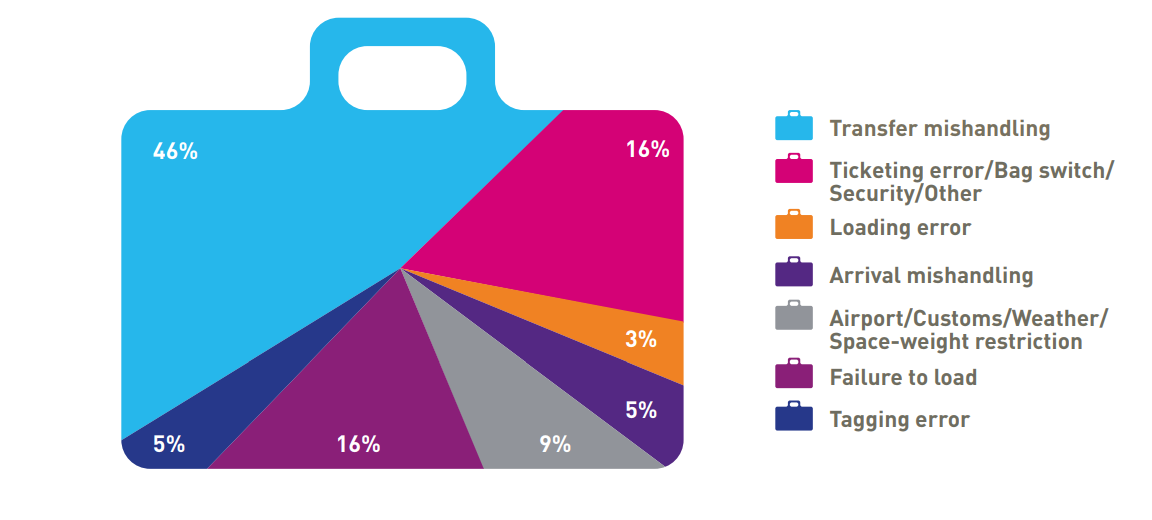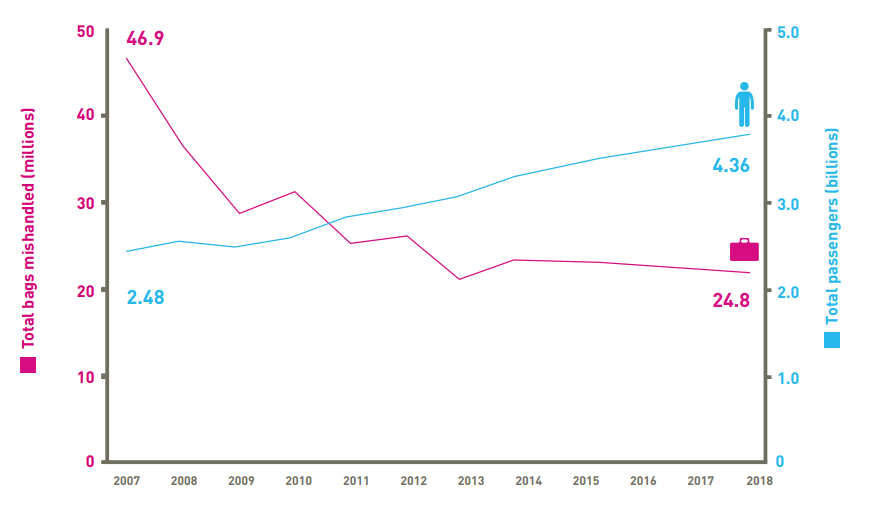These results come as the record drop in the baggage mishandling rate achieved globally over the past decade plateaus, with the rate steady at around 5.7 bags per thousand passengers over the past three years. In 2018, the rate was up marginally (+2.2%) with 5.69 mishandled bags per thousand passengers, but that was on the back of a +6.6% upswing in passenger numbers to 4.36 billion.
Over the past year, an increasing number of airlines and airports have started to introduce tracking at key points in the journey - check-in, loading onto the aircraft, transfers and arrival - to improve baggage management and further reduce the chances of a bag being mishandled.
The latest SITA research provides the first glimpse of the success of this tracking and how technology is starting to overcome one of the regular problems highlighted by corporate travellers impacting their travel experience. It reveals that where bags were being tracked when loaded onto the aircraft, the rate of improvement ranged between 38% and 66% depending on the level of tracking introduced.
Etihad Airways says the 33% improvement in baggage mishandling it recorded in 2018 came from its ability to "efficiently plan and prioritise the loading and off-loading sequence" of baggage into its Abu Dhabi International airport hub. Aegean Airlines recorded a 2.28% reduction in total mishandled bags per 1,000 passengers in 2018 compared to 2017 after it rolled out baggage scanning throughout its network.
CHART - The number of mishandled bags globally was up marginally (+2.2%) with 5.69 mishandled bags per thousand passengers, but that was on the back of a +6.6% upswing in passenger numbers to 4.36 billion Source: SITA's 2019 Baggage IT Insights report
Source: SITA's 2019 Baggage IT Insights report
Away from all the positivity, the number of mishandled bags actually rose +8.9% to 24.8 million in 2018. However this represents less than 0.06% of the estimated 4.27 billion bags checked by the 4.36 billion travellers last year.
More bags obviously makes things more challenging and Peter Drummond, director of baggage at SITA, says everyone across the industry "needs to look beyond the process and technology improvements made in the past decade and adopt the latest technology such as tracking to make the next big cut in the rate of mishandled bags."
CHART - Transferring luggage from one aircraft to another, or from one airline to another remains a major pinch point in the system and accounted for 46% of all delayed bags - marginally down from 2017 to the same proportion as 2015 Source: SITA's 2019 Baggage IT Insights report
Source: SITA's 2019 Baggage IT Insights report
Unsurprisingly, transferring baggage from one aircraft, or airline, to another remains a "pinch point in the journey" acknowledges SITA, and in 2018 it was again the main reason for bags being mishandled. Transfer bags accounted for 46% of all mishandled bags, according to the report.
"Transfer is by far the most difficult stage to track a bag as there are multiple airlines and airports involved," says Mr Drummond. But again, the adoption of new tracking technology at further key points in the journey, such as during the transfer process could go a long way to eliminating mishandling.
CHART - Over the past decade, total number of mishandled bags per annum has actually plummeted 47% from 46.9 million in 2007 to 24.8 million in 2018 Source: SITA's 2019 Baggage IT Insights report
Source: SITA's 2019 Baggage IT Insights report
What it certainly will do is allow airlines and their passengers to keep tabs on where their bags are at every step of the way, and lack of knowledge on the location of a mishandled bag can be the issue that frustrates travellers more than it failing to arrive at the destination.
Three of the top mobile services on passengers' wish-lists relate to tracking the status of their luggage: almost two thirds say they would definitely track their bags on mobile apps, use bag collection information at arrivals and use their mobiles to report mishandled bags. Real-time bag tracking information via mobile apps is on the self-service investment agenda for a majority of airlines over the next three years. They plan to offer bag location status updates and missing bag communications to passengers.
While the baggage mishandling rate is plateauing, it is worth remembering the significant progress that is being made in this are of the journey and at a time that global air travel is growing globally, and at such high rates.
Over the past decade, total number of mishandled bags per annum has actually plummeted 47% from 46.9 million in 2007 to 24.8 million in 2018. This has delivered notable cost savings with the annual bill footed by the industry shrinking 43% over the same timescale to USD2.4 billion, down from USD4.22 billion in 2007.
Delayed bags continues to account for over three quarters of all mishandled bags. Tackling potential operational disruptions is a major technology focus for airlines and predictive analytics capabilities, which can help them identify and address disruptions before they occur is the second main use case for artificial intelligence implementation, says SITA. The breakdown of mishandled bags in 2018 was largely unchanged from 2017, with damaged and pilfered bags representing 18% of mishandling and stolen bags representing 5%.